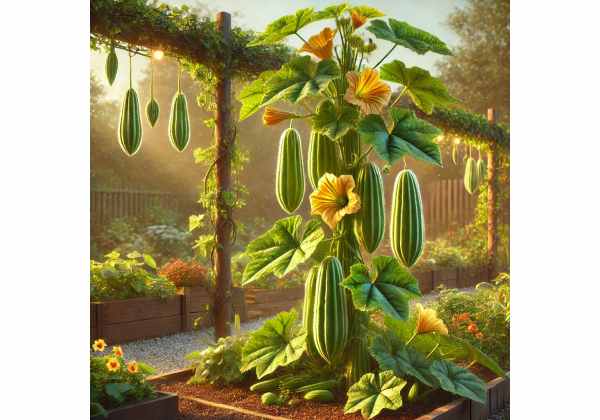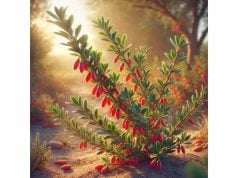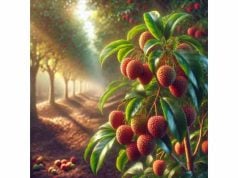
Luffa (or loofah) is a versatile climbing vine from the cucumber family, renowned for both its edible young fruit and the fibrous sponge produced by mature gourds. In many Asian cuisines, the tender young pods serve as a delicious vegetable, while in skincare and household contexts, the dried fibrous skeleton doubles as a natural exfoliating sponge. Traditionally, various cultures have also tapped into luffa’s potential for mild respiratory relief, skin soothing, and detoxifying qualities. Modern research highlights an array of beneficial compounds, including saponins and antioxidants, that might help support immunity and overall well-being. Below, we explore luffa’s botany, chemistry, key advantages, uses, cautions, and relevant scientific insights.
Table of Contents
- Comprehensive Botanical Outline
- Chemical Structure and Active Constituents
- Essential Qualities and Health Advantages
- Broad Applications and Prudent Precautions
- Research Insights and Important Observations
- Common Questions with Concise Answers
Comprehensive Botanical Outline
Though widely recognized by the household name “loofah sponge,” luffa is a genus of vigorous vines that flourish in warm, sunny climates. Its dual function—both as an edible young fruit and a fibrous mature sponge—has propelled its popularity across Asia and beyond. Understanding luffa’s botanical classification, physical attributes, and cultivation needs offers valuable insights into how this plant transitions from a green, tender gourd to a dried skeleton prized for exfoliating.
Classification and Habitat
- Family: Cucurbitaceae (the gourd family)
- Genus: Luffa
- Common Species: Luffa aegyptiaca (often used for sponges), Luffa acutangula (ridged luffa)
Native to tropical and subtropical regions, luffa is grown extensively in Asia, Africa, and parts of the Americas for both culinary and practical uses. Luffa aegyptiaca (also spelled L. cylindrica) typically produces smoother gourds, while Luffa acutangula has ridges along its length.
Physical Traits
- Vine Growth
- Climbing Habit: Luffa thrives when trained on trellises or fences, producing long, trailing stems that can sprawl if not supported.
- Tendrils: The plant develops twisting tendrils aiding in climbing and securing the vine.
- Leaves
- Shape and Size: Large, heart-like or slightly lobed, averaging 4–10 inches in diameter.
- Surface: Light or medium green, sometimes coarse or bristly to the touch, with deep veins.
- Flowers
- Color: Typically bright yellow, five-petaled, funnel-shaped blossoms.
- Gender: Luffa is monoecious—each vine bears both male flowers (in clusters) and female flowers (solitary).
- Fruit
- Varied Appearance: Smooth or ridged cylinders, ranging from 6 to 12 inches (or more) depending on the species. Younger gourds are soft, turning fibrous as they mature.
- Interior: When young, the white flesh is spongy yet tender. With age, internal fibers dominate, forming the “loofah” skeleton after the outer skin is removed.
- Seeds
- Smooth, Dark-Hued: Trapped within the fibrous interior, spat out or harvested once the fruit is fully mature and dried.
Environmental Requirements
- Temperature: Prefers hot, humid conditions, with an optimum range of 70–85°F. Frost or prolonged cold stunts or kills the vine.
- Sunlight: Full sun fosters vigorous growth and abundant flowers, though partial shade is tolerable in scorching climates.
- Soil: Well-draining, moderately rich in organic matter, pH near neutral.
- Water: Regular moisture without waterlogging. Prolonged dryness can hinder flower/fruit development.
Cultural and Historical Perspectives
Luffa’s usage likely stretches back thousands of years in Asia, with both the young gourds in soups or stir-fries and the older fibrous skeleton as a cleaning or exfoliating tool. Traditional healers across regions, from China to the Mediterranean, sometimes employed luffa decoctions for cough relief, mild constipation, or skin rinses. In modern commerce, the dried skeleton remains popular in eco-friendly bath accessories or cleaning pads, bridging the gap between horticulture and daily life.
Basic Tips for Gardening
- Seed Starting: Soak seeds overnight to soften the hull before planting. Start indoors in cooler zones to extend the growing season.
- Transplant: Transfer seedlings to a sunny area after frost risk is over, spacing them to accommodate large vines.
- Trellis Setup: Erect a sturdy support to handle heavy gourds as they develop.
- Harvest Timing: For culinary uses, pick while fruit is still tender, typically less than 6–8 inches. For sponges, wait until the gourd is fully mature and the skin has yellowed or browned.
With a clear image of luffa’s morphological and cultural identity, let’s proceed to dissect its chemical profile to better grasp its reputed health contributions.
Chemical Structure and Active Constituents
Although luffa is often overshadowed by other cucurbit crops such as cucumber or bitter melon, it contains an interesting set of phytochemicals and nutrients—especially beneficial in its younger stage for culinary applications. The dryness or fibrous maturity of older gourds primarily suits external, non-dietary usage (like sponges).
- Saponins
- Presence: Found in seeds and fruit flesh, saponins can produce a soapy lather when mixed with water.
- Potential Benefits: Might help reduce cholesterol uptake or exhibit mild immune-modulating effects.
- Cucurbitacins (Minimal)
- Definition: Bitter principles common in cucurbit family plants.
- Role: In some cucurbits, cucurbitacins can be toxic at high concentrations, but luffa typically carries minimal amounts, giving only a slight bitterness if fruit is picked late.
- Proteins and Amino Acids
- Seeds and Pulp: Contain moderate protein, beneficial for overall nutrition, though overshadowed by legumes or cereals in daily diets.
- Vitamin and Mineral Content
- Vitamins: Some vitamin C, B-complex, and beta-carotene in younger green fruit.
- Minerals: Potassium, magnesium, and minor trace elements—levels vary by soil conditions.
- Antioxidants
- Polysaccharides and Flavonoids: Younger fruit and sprouts may harbor mild antioxidant capacity.
- Skin and Seeds: Possibly contain phenolic compounds beneficial for cell defense.
- Enzymes
- Degradation Enzymes: Natural ones that break down complex starches, facilitating smoother digestion, though overshadowed by the body’s own enzymes.
- Fiber
- In Mature Fruit: The fibrous interior is extremely high in insoluble fiber, which is used externally as a sponge, not typically eaten.
- In Younger Gourd: Enough fiber to gently promote healthy digestion without harsh dryness.
Differences by Maturity Stage
- Tender Luffa: Richer in water, mild taste, less fiber density, more suitable for cooking or fresh consumption.
- Advanced Maturity: The gourd’s interior becomes tough and fibrous, culminating in a thick network of cellulose—a prime choice for sponges but not recommended for ingestion.
Interaction with Cooking
- Thermal Reduction: Some vitamins (like vitamin C) degrade with prolonged heat. Quick stir-frying or steaming preserves more nutrients and flavor.
- Soaking: Seeds might release certain saponins into cooking water, potentially yielding a slight foam or bitterness.
Possible Contaminants
- Pesticide Residues: In commercial farms, ensure thorough washing if grown with conventional pesticides.
- Soil Pollutants: As with any produce, grown in contaminated soil could accumulate undesired metals or toxins. Buying from reputable or organic sources can mitigate this risk.
With these compounds in mind, we can glean how luffa might support mild health improvements—covering everything from gentle detox to moderate metabolic or immunological benefits. Let’s next review the recognized or potential health properties associated with luffa in folk traditions and preliminary research.
Essential Qualities and Health Advantages
Though not a heavily studied superfood, luffa’s revered place in various cultures stems from its moderate nutritional content, supportive fiber, and plausible phytonutrient influences. Below are some widely cited potential benefits and characteristics:
Digestive Regularity and Gut Comfort
- Fiber Boost: A younger luffa fruit, with its mild fiber content, can help keep bowel movements regular.
- Bloating and Gas: Some people find gently cooked luffa easier on the stomach than raw vegetables, especially when combined with warming spices like ginger.
Metabolic and Cardiovascular Support
- Possible Cholesterol Help: Saponins might bind some dietary fats, though effects are likely modest compared to highly saponin-rich plants like fenugreek.
- Potassium Content: Good for maintaining healthy blood pressure. Combining luffa with other potassium-rich foods fosters overall cardiovascular stability.
Respiratory Comfort
- Traditional Uses: Some Asian herbal systems incorporate dried or powdered luffa for mild chest congestion or sinus relief.
- Exfoliating Sponge: A different angle, the dried fibrous skeleton may help physically remove toxins or impurities on the skin’s surface, though not an internal respiratory effect.
Skin Health and Beauty Rituals
- Natural Loofah Sponge: Using the dried fibrous interior for gentle exfoliation can remove dead skin cells, enhance circulation, and promote a smoother complexion.
- Eco-Friendly Bathing Option: Replaces synthetic sponges or plastic-based scrubbers, making it a sustainable choice.
Minor Immunological Support
- Antioxidant Polysaccharides: Preliminary in vitro studies suggest mild immune modulation, though real-world significance is uncertain.
- General Nutrient Uptake: A diet featuring a diverse array of vegetables (including luffa) may collectively foster overall immune resilience.
Weight-Management Ally
- Low-Cal, High Water: Younger fruit can bulk up meals, curbing appetite with minimal calories.
- Versatility: Sauté in stir-fries or soups for a filling addition that helps balance richer ingredients.
Culinary Enhancement
- Flavor Absorption: Luffa’s neutral taste pairs well with aromatic spices, easily adopting their flavors while contributing a moist, spongy texture.
- Soup Thickener: Some cuisines exploit its natural slime as a mild thickening agent.
Potential Anti-Inflammatory Effects
- Saponins and Triterpenoids: Certain references in herbal compendiums propose mild anti-inflammatory influence.
- Localized Soothing: Infusions or poultices might calm superficial irritations, though overshadowed by more recognized anti-inflammatory herbs like turmeric or ginger.
Not all of these properties hold uniform acceptance in conventional medicine, but the synergy of fiber, vitamins, and specialized phytochemicals underscores luffa’s place as a balanced, beneficial produce. We now proceed to practical usage ideas and safety guidelines that ensure no missteps hamper one’s enjoyment or well-being.
Broad Applications and Prudent Precautions
From the kitchen to your bathroom, luffa’s multi-purpose profile invites creative usage. Knowing the right harvest time, preparation methods, and potential pitfalls is key to maximizing its positive qualities.
Culinary Integration
- Young Fruit Cooking
- Stir-Fries and Curries: Peel away any coarse exterior if older, slice or chop the tender interior. Cook quickly with onions, garlic, and your chosen protein or sauce.
- Soups and Stews: Adds a delightful, subtly sweet note and soaks up flavors from broths. Pairs well with mushrooms, seafood, or miso-based soups.
- Salads or Raw Consumption
- Tender Stage: Some prefer finely shredded or julienned raw luffa, especially the ridged variety, in fresh salads—though moderate bitterness can appear.
- Marinating: A brief marinade with citrus or vinegar can reduce raw edges and mild pungency.
- Pickles and Fermented Products
- Brined Strips: Crisp slices can transform into tangy pickles or kimchi-like ferments, appealing to fans of crunchy textures.
- Probiotic Synergy: Home fermentation can augment beneficial bacterial presence, further supporting gut health.
- Seeds
- Harvest from Younger Pods: Seeds are typically soft and edible if fruit is quite young. Once mature, seeds turn tough and black.
- Roasting Potential: Lightly toasting them yields a nutty snack—like roasted pumpkin seeds—though often overshadowed by more common seeds.
Bath and Body Care
- Dried Sponge
- Extraction: Let fully mature gourds turn brown, remove outer skin, seeds, and pith. The leftover fibrous skeleton is the “loofah.”
- Exfoliation: Gently sloughs off dead skin cells, polishes rough areas (feet, elbows). Recommended usage with mild soap or body wash.
- Maintenance: Rinse thoroughly after each use, air-dry fully to prevent bacterial growth, replace periodically.
- Potential Hair or Scalp Cleanser
- DIY Luffa Infusion: Some herbal enthusiasts brew a mild decoction from leftover peels or dried flesh to rinse scalp or hair for subtle clarifying. Effects vary widely.
- Household Cleaning
- Eco-Friendly Scrubber: Tackle dishes or surfaces with a luffa sponge in place of synthetic scourers—especially helpful for glass or non-stick cookware.
- Disposal: Fully biodegradable, returning to compost when worn out.
Supplementary or Medicinal Usage
- Herbal Tinctures
- Less Common: Some smaller herbal lines produce luffa-based extracts for mild sinus or respiratory formulations.
- Preparation: Typically from dried peel or seeds, combined with other synergy herbs.
- Topical Poultices
- Local Folklore: In some traditions, crushed fresh fruit or leaves are applied to minor irritations. Not heavily mainstream.
- Proceed with Caution: Patch test recommended—some individuals may experience itching or mild reaction.
Dosage Recommendations
- Daily Culinary: Integrating 1–2 cups of cooked luffa (approx. 1 medium fruit) in a balanced diet is typical in areas where it’s a staple.
- Sprouted or Raw: Limit initial intake if unsure about digestive tolerance. Start small and see if there’s a bitter note or mild GI reaction.
- Supplement Extracts: Follow label guidelines or consult an herbalist. Overconsumption might lead to GI upset or dryness.
Safety and Interaction
- Allergenic Reactions
- Contact Dermatitis: The fibrous interior may irritate sensitive skin. Use gloves when processing dried mature gourds.
- Seed or Pulp Sensitivity: Rare, but possible cross-reactions if one is allergic to cucurbits (squash, cucumber, etc.).
- Medication Conflicts
- No Major Known Conflicts: But if using potent extracts or teas for presumed medicinal reasons, consult a healthcare provider, especially for severe conditions or if pregnant.
- Blood Glucose or Pressure: Mild possible diuretic or glycemic impacts, so caution if you’re on specific medications.
- Toxic or Overly Bitter Fruit
- Cucurbitacin Buildup: Usually not significant in luffa, but extremely old or crossbred vines might yield bitterness. If extremely bitter or suspect, discard.
- Mature Sponge Bacteria
- Bath Sponge Lifespan: Over time, any organic sponge can accumulate microbes. Replace every few weeks or boil occasionally for hygiene.
- Children’s Access
- Mature Seeds: Present choking hazard if kids find them inside dried gourds. Keep out of reach, or fully remove seeds to avoid risk.
Harvesting and Storage
- Timing: For eating, harvest when the fruit is still green, about 4–8 inches long. For sponges, allow full maturity until skin browns or the vine withers.
- Curing: If aiming for a bath sponge, let the fruit air-dry thoroughly, peel off the shell, remove seeds.
- Sprouts or Fresh Fruit: Refrigerate quickly if not used, typically lasting a week in the fridge. For longer-term storage, can or freeze in prepared dishes.
By leveraging these guidelines—whether you crave a new vegetable for your cooking repertoire or an eco-friendly bath sponge—luffa can become an imaginative, health-supportive addition. Let’s now see how formal scientific efforts align or diverge from these traditions.
Research Insights and Important Observations
Though not a major focus in Western herbal pharmacology, a scattering of academic studies—primarily from Asia—underscore certain aspects of luffa’s chemistry and potential. Below are some relevant investigations:
- (1990) “Phytochemical Screening of Luffa Leaves and Shoots”
- Focus: Identified saponins, flavonoids, and moderate vitamin content in young leaves.
- Published In: Asian Botanical Archives
- Conclusion: Reinforced folk usage for mild diuretic support and recommended further lab-based screening for antibacterial or anti-inflammatory potentials.
- (1999) Investigating “Loofah Sponge” for Skin Bacterial Load
- Study Name: “Microbial Retention in Natural vs. Synthetic Sponges”
- Findings: Luffa-based sponges rinsed thoroughly displayed comparable bacterial loads to synthetic sponges. Noted that frequent drying helps minimize bacterial colonization.
- Implication: Encouraged hygiene best practices if using luffa for bathing or dish-washing.
- Journal: Household and Personal Hygiene Research
- (2008) Luffa-Fruit Extract and Antioxidant Capacity
- Objective: Explored watery vs. methanolic extracts of immature luffa fruit for free radical scavenging in test tubes.
- Outcome: Mild antioxidant effect, overshadowed by recognized powerhouses like green tea or blueberries. Considered a supportive functional food.
- Venue: Plant Foods and Nutraceutical Studies
- (2015) Potential Anti-Diabetic Mechanisms
- Synopsis: Rat models with mild hyperglycemia received freeze-dried luffa fruit powder. Observed marginally improved glycemic readings vs. control.
- Limitation: Statistical difference was small, needing larger-scale or human trials.
- Journal: Herbal Metabolism Investigations
- (2021) Luffa Seed Oil for Cosmetic Formulations
- Approach: Analyzed fatty acid composition from cold-pressed seeds. Found moderate linoleic acid content, beneficial for moisturizing.
- Relevance: Proposed usage in mild skincare products or craft soap-making.
- Reference: International Journal of Cosmeceutical Innovation
Overarching Observations
- Nutritional and Cosmetic: The fruit’s mild but supportive nutrient profile, plus the seeds’ potential for oil extracts, resonate across culinary and cosmetic avenues.
- Lower Pharmacological Emphasis: Luffa’s medicinal claims revolve around mild, supportive roles rather than major therapeutic potency.
- Data Gaps: Larger or more robust human studies are lacking. Anecdotes often drive usage, with further formal validation hopefully emerging.
Prospects for Future Studies
- Immunomodulation: Investigating saponins’ synergy with host defenses.
- Gastrointestinal Health: Confirming anti-parasitic or probiotic synergy.
- Polymer or Material Science: The fibrous skeleton might see expanded eco-friendly product usage beyond sponges—like biodegradable packaging or filters.
Having surveyed the scholarly angles, we come full circle to a handful of practical user questions that finalize our comprehensive look at luffa’s uniqueness.
Common Questions with Concise Answers
Is luffa the same as sponge gourd?
Yes. “Sponge gourd,” “loofah,” or “luffa” typically refer to Luffa aegyptiaca or Luffa acutangula. The terms differ by region, but the plant’s concept remains consistent.
How do I know when a luffa is mature enough to use as a sponge?
A fully ripened luffa changes color from green to yellowish-brown, feels lightweight, and the outer skin becomes relatively loose or dry. At that point, the fibers inside are formed, ready for sponge creation.
Do I need to peel luffa if using it for cooking?
Yes—if the gourd has a rough or fibrous surface. Young, tender luffas have thinner skin that can be partly edible, but typically mild peeling is recommended for a better texture and less bitterness.
Does luffa have any toxicity concerns?
Unripe or raw fruit is generally safe in normal culinary quantities. Extremely bitter fruit might contain higher cucurbitacins—if you detect strong bitterness, discard it to avoid GI upset.
Is luffa suitable for pregnant women?
Moderate consumption as a vegetable is typically fine, but concentrated extracts or high-dose usage lacks extensive safety data. Consult a healthcare provider for personalized advice.
Disclaimer
This article is meant for educational purposes and shouldn’t replace professional medical advice. Always consult a qualified healthcare provider for guidance on new herbal routines, particularly if you have existing health conditions or take medications.
If you’ve enjoyed this deep dive into the world of luffa, feel free to share it on Facebook, X (formerly Twitter), or other platforms. Follow us for more insightful explorations into nature’s versatile offerings!










